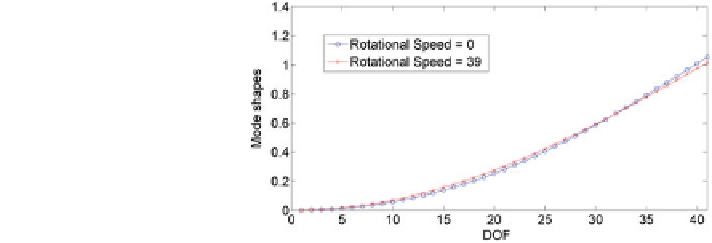Environmental Engineering Reference
In-Depth Information
Fig. 9.5 Varying mode
shapes w.r.t. rotational speed
for mode 1
figure indicates that the rotational speed significantly affects the modal frequency
of the blade. Due to the augmentation of structural stiffness as a result of the
centrifugal force, the modal frequency increases with the rotational speed gradu-
ally. For the undamaged structure, the first frequency is increased by approxi-
mately 11.35 % when the rotational speed changes from 1 to 50 rad/s. At the same
time, the modal frequencies decrease due to structural damage. Therefore, in some
cases, the usual damage detection method will mistake the rotational speed drop
for structural damage. Figure
9.5
shows the effects of the rotational speed on the
mode shapes for the first mode. As the figure shows, the presence of additional
stiffness also changes the mode shapes.
9.2.3.3 Results of Damage Detection Based on PCA
As stated above, the method presented in this chapter was applied to a simulation
of a small wind turbine blade. Structural vibration responses were obtained under
different rotational speeds by using ANSYS. After collecting all of the simulation
output, the steps in the proposed damage detection and modal variation rejection
algorithm may be summarized as follows:
1. Compute the loading matrix T using a set of reference data;
2. Apply the PCA method on the undamaged cases to obtain the damage index
NI
u
, control limits UL and LL;
3. Run the PCA method on the test data to obtain their damage indexes NI
t
;
4. Estimate whether the NI
t
are within the control limits.
The results for undamaged state obtained with the PCA method are shown in
Fig.
9.6
; three straight lines correspond to UL, CL and LL, as defined in Eq.
9.11
.
The 200 nodes on the polyline correspond to the specific rotational speeds, which
are within the range from 0 to 50 rad/s under healthy conditions. Not all nodes lie
on a straight line due to the nonlinear relationship between the frequencies and
rotational speeds. In fact, we expect to obtain a straight line that is independent of
the rotational speed such that the effect of the rotational speed can be removed.

